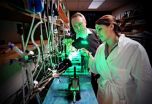(Press-News.org) PROVIDENCE, R.I. [Brown University] — Instances in which parents kill their children may seem so horrifying and tragic that they defy explanation. Published scientific and medical research, meanwhile, doesn't offer much epidemiological context to help people understand patterns among such heinous crimes. A paper in the March edition of the journal Forensic Science International provides the first comprehensive statistical analysis of filicide in the United States, drawing on 32 years of data on more than 94,000 arrests. The study also explores possible underlying psychiatric and biological underpinnings of filicide.
The research could help identify valid patterns among filicide cases, said lead author Dr. Timothy Mariano, a third-year psychiatry resident in the Alpert Medical School of Brown University, which could in turn aid in studying the causes of filicide.
"To know more about the epidemiology of this crime will hopefully help medical practitioners to identify people who are at risk for committing such crimes and that will help us with prevention, which is the ultimate goal of this research," Mariano said.
A broad understanding of filicide, for instance, can help disabuse professionals and members of the public of certain myths and stereotypes about the crime, said senior author Dr. Wade Myers, professor of psychiatry and human behavior at Brown and a forensic psychiatrist at Rhode Island Hospital. For example, the data show that men are about as likely as women to kill infants. Stepchildren are not more likely than biological children to die at their parents' hands, and nearly one in five filicides (18 percent) are killings of adult children, suggesting filicide is a lifetime risk.
Statistical context
The data in the study, first published online last month, come from the U.S. Federal Bureau of Investigation's Supplementary Homicide Reports (SHR) database. Mariano, Myers, and co-author Heng Choon Chan looked at 632,017 arrests between 1976 and 2007, finding that 94,146 cases (14.9 percent) were filicides. The database includes information on the ages, genders, and races of the victims and alleged offenders, as well as the means employed to commit the murder.
Over time, the total number of cases in the country has remained relatively stable at around 3,000 a year. There may be some good news, however. Not only has the number drifted somewhat downward since the early 1990s, but also the numbers did not climb with population growth over the last three decades.
Close to three-quarters (72 percent) of the children killed were age 6 or younger. One-third were infants (children less than 1 year of age). Only about 10 percent of children killed were between ages 7 and 18. Adult offspring were the balance of the victims. Male children were more likely to be killed (58.3 percent) than female children. About 11 percent of victims were stepchildren, which is on the low end of the estimated proportion of U.S. children (10-20 percent) who live with a stepparent.
Among offenders, while fathers were about equally likely to kill an infant, they were more likely to be the alleged murderer of children older than a year, especially when the children were adults (fathers were the offenders in 78.3 percent of those cases). Overall, fathers were the accused murderer 57.4 percent of the time.
The data allowed the researchers to determine the most common filicide scenarios. A father killing a son was the most likely (29.5 percent of cases), a mother killing a son (22.1 percent) follows. A mother was slightly more likely to kill a daughter (19.7 percent of cases) than a father was (18.1 percent). The rarest instances were stepmothers killing either a stepson (0.5 percent) or a stepdaughter (0.3 percent).
The researchers found that the most common method of killing was with "personal weapons," such as by the beating, choking, or drowning of victims. Parents used these means in 69 percent of murders of infants. As victims aged, firearms were more common, becoming the weapon used in 72.3 percent of the cases in which the victim as an adult. Men were much more likely to use guns than women. Across the board, parents rarely used contact weapons (such as a bat) or edged weapons (such as a knife). While stepparents weren't overrepresented in the study, they were twice as likely as biological parents to use guns to (40 percent vs. 21 percent).
Biological underpinnings
Before Mariano worked with Myers and Chan to analyze the Supplementary Homicide Reports data, he had begun studying filicide while on a psychiatry rotation in medical school at Case Western Reserve University. There he had been reviewing the scientific literature on animal models of filicide. That published work, combined with studies of people and trends in the arrest statistics, offers a way for mental health professionals to develop hypotheses about the causes of filicide, he said.
In the current paper, Mariano synthesizes three main hypotheses about these underlying motives. One is that at least some parents who commit filicide have mental illness that derives from low levels of the neurotransmitter serotonin. Not only is that borne out in some animal studies, but the most typical ages of filicidal parents in the SHR data (18-30 years) are also the age at which many serotonin-related illnesses occur, like depression and schizophrenia.
Looking at the substantial differences that gender appears to make in the SHR data, a second hypothesis focuses on sex hormones. High levels of testosterone appear to coincide with higher rates of filicide in animal studies, for example, and in the crime statistics men were more likely to commit filicide, especially after victims were older than a year.
The final hypothetical motive category pertains mostly to those youngest of victims, "the unwanted child." This evolutionarily motivated idea, also informed by other studies, suggests that parents, particularly young mothers, may kill young children who are sick or for whom they feel they cannot provide care.
Neither the statistics nor the hypotheses definitively explain filicide, but they provide researchers with a basis to focus their inquiries, Mariano and Myers said.
"Hopefully future research will continue to improve society's ability to identify, manage, and treat populations at risk," they conclude.
INFORMATION:
The research was partially funded by a grant from the National Institutes of Health (grant: T32GM007250).
Analysis: 32 years of US filicide arrests
2014-02-25
ELSE PRESS RELEASES FROM THIS DATE:
CWRU researchers find byproducts of bacteria-causing gum disease incite oral cancer growth
2014-02-25
Researchers from Case Western Reserve University have discovered how byproducts in the form of small fatty acids from two bacteria prevalent in gum disease incite the growth of deadly Kaposi's sarcoma-related (KS) lesions and tumors in the mouth.
The discovery could lead to early saliva testing for the bacteria, which, if found, could be treated and monitored for signs of cancer and before it develops into a malignancy, researchers say.
"These new findings provide one of the first looks at how the periodontal bacteria create a unique microenvironment in the oral cavity ...
Eliminating maternal mortality could extend life expectancy in reproductive ages
2014-02-25
Maternal death rates represent the single largest health discrepancy between developed and developing populations, with nearly all - over 99% -- maternal deaths worldwide occurring in developing countries and over half of them in sub-Saharan Africa countries. Eliminating maternal mortality, which is defined as the deaths related to pregnancy, would result in a gain of over a half year (0.6 years) in life expectancy worldwide, according to a new study by researchers at Johns Hopkins Bloomberg School of Public Health. The study is published February 13 in PLOS ONE.
Over ...
Magnetic medicine
2014-02-25
Using tiny particles designed to target cancer-fighting immune cells, Johns Hopkins researchers have trained the immune systems of mice to fight melanoma, a deadly skin cancer. The experiments, described on the website of ACS Nano on February 24, represent a significant step toward using nanoparticles and magnetism to treat a variety of conditions, the researchers say.
"Size was key to this experiment," says Jonathan Schneck, M.D., Ph.D., a professor of pathology, medicine and oncology at the Johns Hopkins University School of Medicine's Institute for Cell Engineering. ...
3-D printer creates transformative device for heart treatment
2014-02-25
Igor Efimov, PhD, at the School of Engineering & Applied Science at Washington University in St. Louis and an international team of biomedical engineers and materials scientists have created a 3-D elastic membrane made of a soft, flexible, silicon material that is precisely shaped to match the heart's epicardium, or the outer layer of the wall of the heart. Current technology is two-dimensional and cannot cover the full surface of the epicardium or maintain reliable contact for continual use without sutures or adhesives.
The team can then print tiny sensors onto the membrane ...
Vitamin A may help boost immune system to fight tuberculosis
2014-02-25
Tuberculosis is a major global problem, affecting 2 billion people worldwide and causing an estimated 2 million deaths annually. Western countries are once again tackling the disease, with recent outbreaks in Los Angeles and London.
The rise of drug-resistant TB, called a "ticking time bomb" by the World Health Organization, and the high cost of fighting the disease highlight the need for new approaches to treatment.
In findings published in the March 1 issue of the Journal of Immunology, UCLA researchers investigating the role of nutrients in helping the immune ...
Discovery of a 'conductor' in muscle development
2014-02-25
Montréal, February 25, 2014 – A team led by Jean-François Côté, researcher at the IRCM, identified a ''conductor'' in the development of muscle tissue. The discovery, published online yesterday by the scientific journal Proceedings of the National Academy of Sciences (PNAS), could have an important impact on the treatment of muscular diseases such as myopathies and muscular dystrophies.
"For several years, we have been studying myogenesis, a process by which muscles are formed during embryonic development," says Jean-François Côté, PhD, Director of the Cytoskeletal Organization ...
Psychological side-effects of anti-depressants worse than thought
2014-02-25
LIVERPOOL, UK – 26 February 2014: A University of Liverpool researcher has shown that thoughts of suicide, sexual difficulties and emotional numbness as a result of anti-depressants may be more widespread than previously thought.
In a survey of 1,829 people who had been prescribed anti-depressants, the researchers found large numbers of people – over half in some cases – reporting on psychological problems due to their medication, which has led to growing concerns about the scale of the problem of over-prescription of these drugs.
Psychologist and lead researcher, Professor ...
New record set for data-transfer speeds
2014-02-25
WASHINGTON, Feb. 25, 2014 – Researchers at IBM have set a new record for data transmission over a multimode optical fiber, a type of cable that is typically used to connect nearby computers within a single building or on a campus. The achievement demonstrated that the standard, existing technology for sending data over short distances should be able to meet the growing needs of servers, data centers and supercomputers through the end of this decade, the researchers said.
Sending data at a rate of 64 gigabits per second (Gb/s) over a cable 57 meters long using a type ...
NHS Scotland reduces post-code lottery for hip replacement surgery
2014-02-25
Tuesday 25 February – A reduction in the post-code lottery for hip replacement surgery has been achieved in Scotland without recourse to the private sector, according to new research published in the Journal of the Royal Society of Medicine. Using NHS Scotland data, researchers at the Centre for Primary Care and Public Health at Queen Mary University of London with colleagues from the University of Edinburgh and Lothian University Hospitals NHS Trust, show that access to hip replacement increased and geographical inequalities improved across all geographical health boards ...
Researchers generate new neurons in brains, spinal cords of living adult mammals
2014-02-25
DALLAS, Feb. 25, 2014 – UT Southwestern Medical Center researchers created new nerve cells in the brains and spinal cords of living mammals without the need for stem cell transplants to replenish lost cells.
Although the research indicates it may someday be possible to regenerate neurons from the body's own cells to repair traumatic brain injury or spinal cord damage or to treat conditions such as Alzheimer's disease, the researchers stressed that it is too soon to know whether the neurons created in these initial studies resulted in any functional improvements, a goal ...



